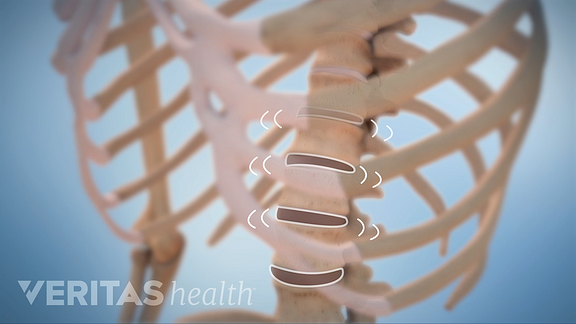Our backs crack for myriad reasons. But what is making this sound? And when should it concern me?
Read on to learn about what makes the cracking sound when you twist or bend your spine, when the sound is normal, and when it may indicate a developing problem in the joints, bones, and/or muscles of your spine.
Find out the 3 common causes of joint crepitus. Watch: Video: Why Do My Joints Crack?
The cracking, popping, or grating that you experience under your skin is called crepitus and usually originates from your joints, but may also develop within your bursae, tendons, or other soft tissues.
Depending on the cause, spinal crepitus can be:
- Crepitus by cavitation:1,2 An audible pop or crack, which may occur during normal movement or when the spine is moved near its end range of motion. Cavitation can occur naturally with exercise or motion and can be induced by a health professional, such as a chiropractor, or osteopathic physician. Cavitation is usually normal and painless and is typically not a cause for concern.
- Arthritic crepitus:3 A snap, click, or coarse grating sensation when you move your spine (or other joints), which is typically caused due to wear and tear within the joints (osteoarthritis).
Crepitus may indicate an injury to a bone or soft tissue.3,4 Sometimes, you may feel a vibration instead of an actual sound.3
The type of sound depends on its origin
Motion-related sounds from your spine are usually produced when you bend forward or rotate the spine.3 The sound can originate from one or more of the following structures:
- Facet joint capsule. Cavitation mostly occurs within your facet joint (joint between your vertebrae) capsule and causes a crack or pop. This sound is produced when the air pressure within the joint changes suddenly—causing bubbles within the joint fluid to form and/or collapse.2,3 This sound is similar to the one produced when you crack your knuckles and is not a sign of joint injury or arthritis.
- Facet joint. When the facet joint surfaces become rough and do not glide smoothly, grating crepitus may be felt. This sound may indicate damaged cartilage in these surfaces resulting from arthritis. More advanced facet arthritis may cause bone-on-bone grinding.4
Watch Facet Joints Video
- Connective tissue. Spasm in the vertebral muscles, roughening of tendons, or adhesions in connective tissues may produce a snapping or grating crepitus during movement.3,4 Connective tissues can also produce normal sounds when they stretch slightly and snap back into place (such as during shoulder movements).
- Disc. Movement of a disc fragment within the spinal facet joint may produce a click sound.4
Watch Spine Anatomy Overview Video
Crepitus may also occur when the movement in your facets is less (producing laxity)3,4 or more (producing instability).2 Crepitus typically increases with age.3
See The Truth About Back Cracking and Grinding
When spine cracking may indicate a problem
If your spine makes cracking sounds, here are a few pointers to help you figure out if the sound is normal or a cause for concern.
Normal joint sounds
Normal sounds are usually felt as an audible crack or pop when you move. Typical characteristics of normal spinal joint sounds are:
- They are painless and can be repeated again
- A repeat is possible only after a gap of a few minutes; the exact time period differs for every individual
A repeat sound can be produced if you are stationary or even if you are constantly moving your back.
Normal joint crepitus sounds produce certain anatomical changes within the joint, such as:
- Production of a gap between the joint surfaces1,2
- Breaking up of connective tissue adhesions between the joint surfaces1,2
- Stimulation of nerves and muscles around the joint2
- Improvement of the range of motion of the joint2
This type of sound is usually more common in men.1
Abnormal joint sounds
Abnormal joint sounds typically have the following characteristics:
- They are usually associated with pain, swelling, collection of fluid, and/or a history of injury
- These sounds can result from degeneration, instability, soft tissue damage, fracture, and/or as a result of past surgical procedures
- The sounds may repeat often, without a refractory period
If you are in doubt or if your back-cracking sound is associated with pain, it is advised to see a doctor for an accurate diagnosis. Intermittent and painless cracking is usually normal and not a cause for concern.
Learn more:
Referrence
- 1.Cramer GD, Ross K, Raju PK, et al. Quantification of cavitation and gapping of lumbar zygapophyseal joints during spinal manipulative therapy. J Manipulative Physiol Ther. 2012;35(8):614–621. doi:10.1016/j.jmpt.2012.06.007
- 2.Cramer GD, Ross K, Pocius J, et al. Evaluating the relationship among cavitation, zygapophyseal joint gapping, and spinal manipulation: an exploratory case series. J Manipulative Physiol Ther. 2011;34(1):2–14. doi:10.1016/j.jmpt.2010.11.008
- 3.Cramer GD, Budavich M, Bora P, Ross K. A Feasibility Study to Assess Vibration and Sound From Zygapophyseal Joints During Motion Before and After Spinal Manipulation. J Manipulative Physiol Ther. 2017;40(3):187–200. doi:10.1016/j.jmpt.2017.01.003
- 4.Ombregt L. Clinical diagnosis of soft tissue lesions. In: A System of Orthopaedic Medicine. Elsevier; 2013:53-82.e2. doi:10.1016/b978-0-7020-3145-8.00004-1

